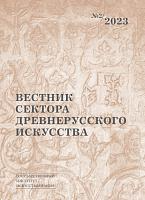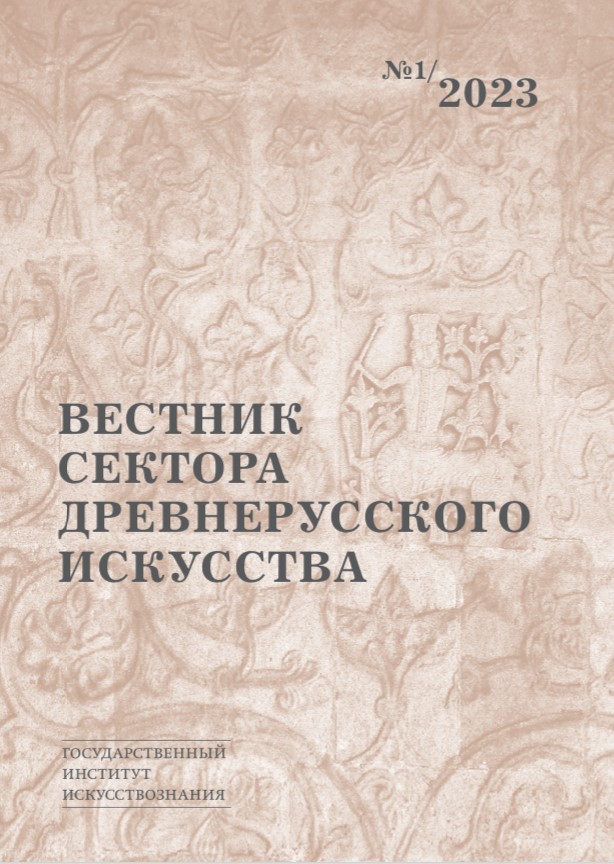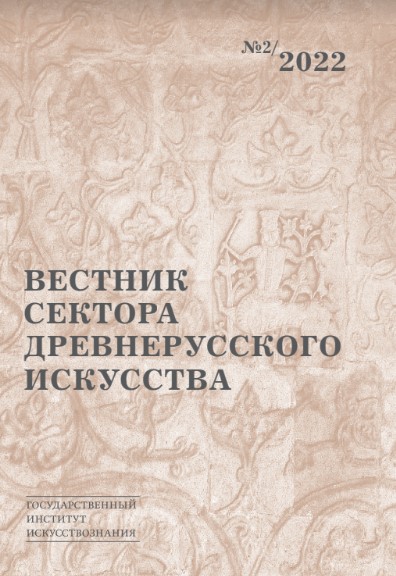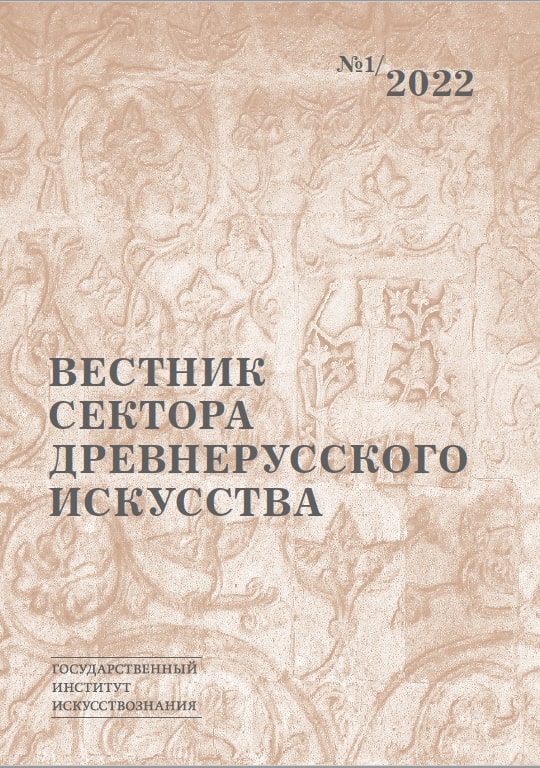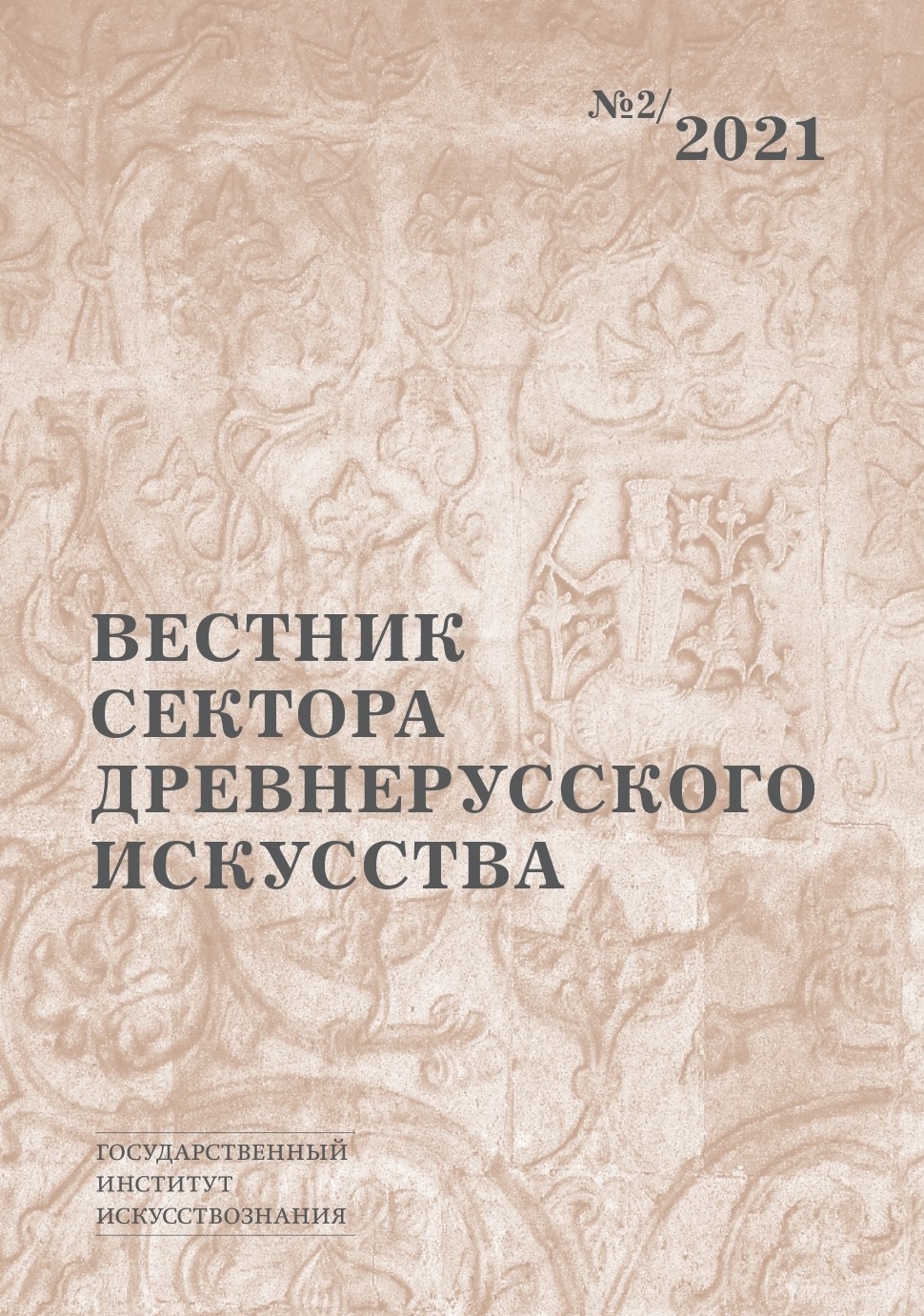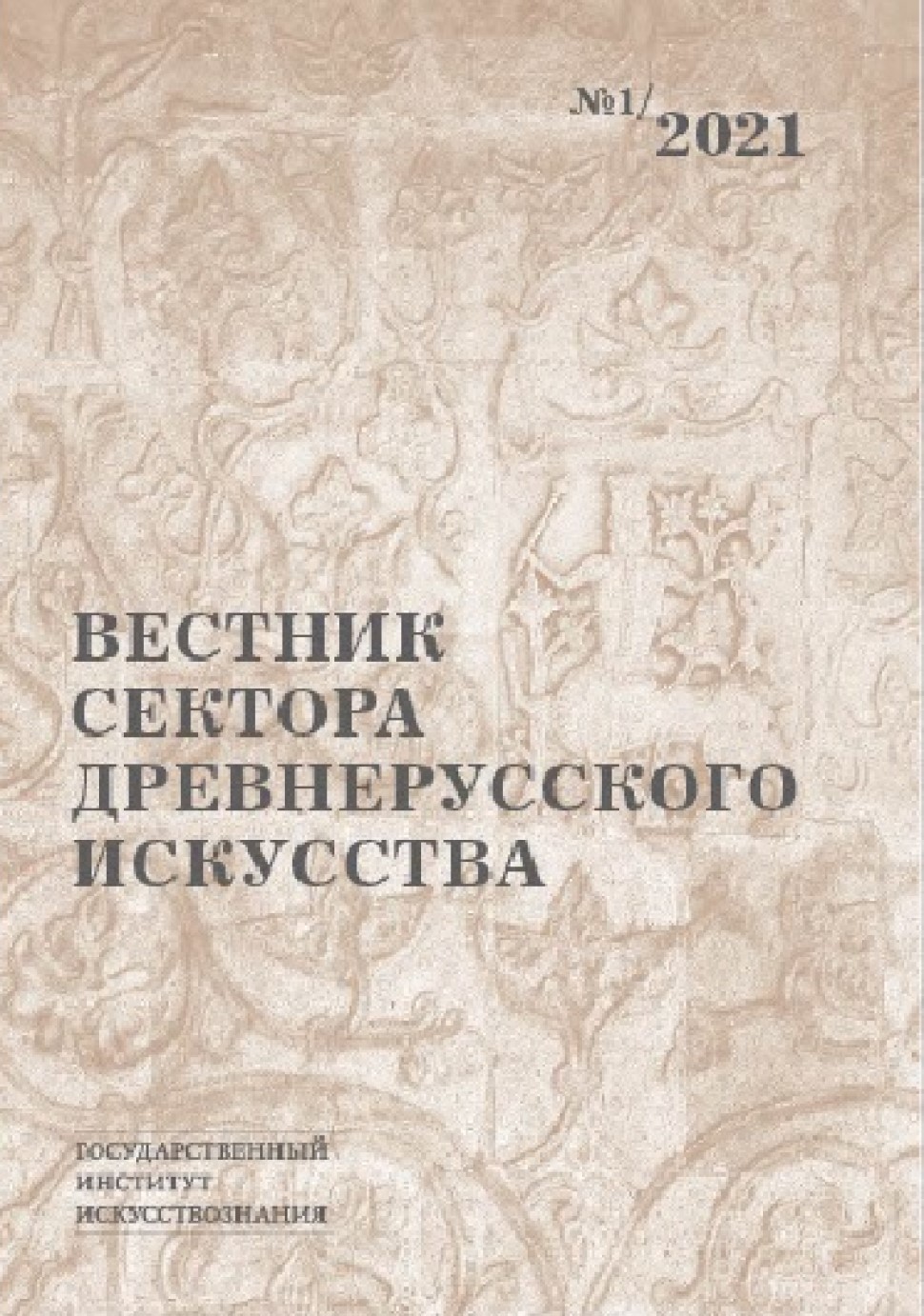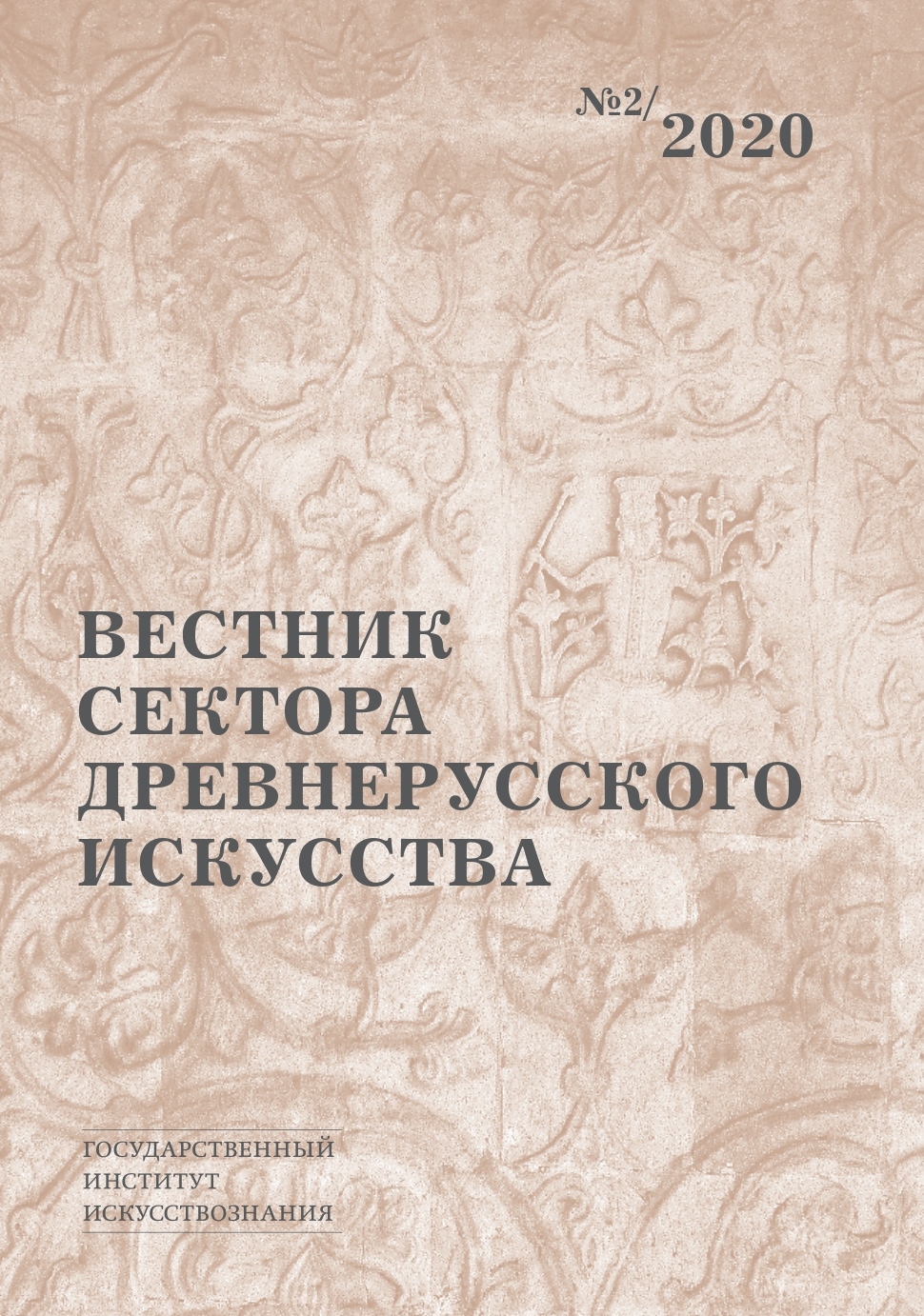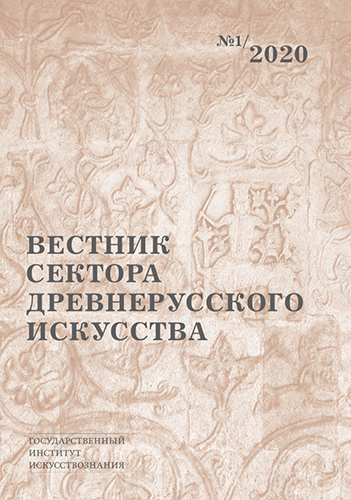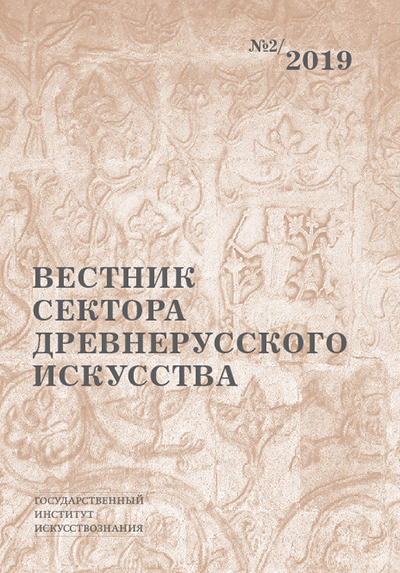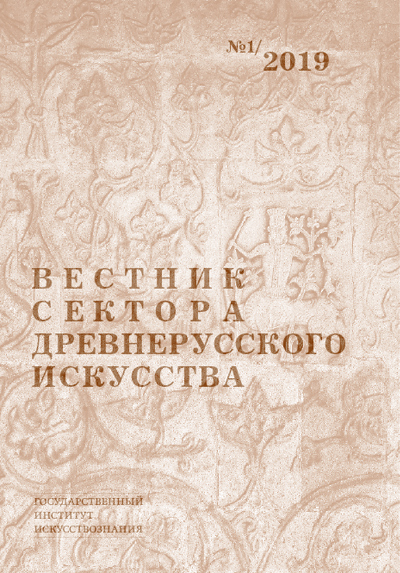2023 ¹ 2
Articles
Iuliia Loshina, Irina Sterligova. A forgotten monument of ancient Russian cloisonne enamel: small icon from the Old Ryazan collection of A. V. Selivanov.Abstract
The first publication of a gold plaque with the image of Christ, found at the Old Ryazan settlement in 1888. The shape and size of the plaque suggest that it could decorate the so-called “Zionets” - tetrahedral pendants in the form of a miniature temple. The artistic features of the image connect it with the works of medieval Russian enamellers of the first half of the 12th century.
Keywords
Finds of 1888 in Old Ryazan, ancient Russian cloisonné enamels, gold jewelry with sacred images.
Tatiana Tsarevskaya. The study of monumental painting of Veliky Novgorod in the second half of the 14th – first third of the 15th century: results and prospects of research (issues of dating and attribution)
Abstract
The path of discovery and study of the frescoes of Veliky Novgorod in the second half of the 14th – first third of the 15th centuries, covering more than a century, today already becomes the subject of research in itself both from the point of view of the formation of national art criticism as a field of knowledge, and from the standpoint of the phenomenology of the spirit. At the same time, in order to identify issues that have not yet been satisfactorily resolved along this path, it is necessary to systematize and rethink the vast baggage of sometimes contradictory information concerning the fresco heritage of Veliky Novgorod. The article focuses on some results and prospects in the study of stylistic attribution of monuments of the period under review and the problem of their dating.
Keywords
Monumental painting, Veliky Novgorod, fresco, Theophanes the Greek, Volotovo, Church of Theodore Stratelates on the Brook, Old Russian art, historiography
Vladimir Sedov. The church of St. Blaise in Novgorod. Part I: structure
Abstract
The article is devoted to the Church of St. Blasius on Volosov Street (1407) in Novgorod. This monument of the
Novgorod architectural school, standing in the city center, restored in the 1950s according to the project of the architect D. M. Fedorov, remains practically unstudied due to the fact that materials from the middle of the 20th century devoted to the research and restoration of the monument were not published. The restored forms of the building seemed to obscure the original architecture. Based on graphic sources, the author shows those genuine parts of the structure, on the basis of which one can judge the square, wide proportions of the temple, and also talks about the pillars, vaults and internal partitions, which allow to analyze the organization of the internal space of this building. The temple is compared with contemporaneous and earlier buildings of Novgorod architecture.
Keywords
Russian medieval architecture, early 15th century, Veliky Novgorod, Church of Blaise, architecture, construction, vaults
Anna Manukyan. The Image of the Good Thief from the Collection of the Museum of the Russian Icon: Iconography.
Abstract
The Good Thief icon from the Collection of the Museum of the Russian Icon named after Mikail Abramov is one of the earliest Russian examples representing the Good Thief alone. Even though the panel’s iconography conforms to the Late Medieval Russian tradition, it features a number of unusual details, some of them even unparalleled. The cross neither rests on the Thief’s shoulder nor is held in his arms, as the tradition dictates, but soars in the air behind his back. This unique iconographic feature might be alluding to the main feature of the Good Thief’s relic cross, which was famous for its miraculous capacity to ‘hang’ in the air without any support. The cross, upon which the Good Thief was crucified and died, was housed in Cyprus in the Stavrovouni monastery and was an object of pilgrims’ devotion.
At the bottom of the panel, between the branches of the left tree planted at the Thief’s feet, the outline of an axe is discernible. The iconographer could have intended to portray Saint John the Baptist, thus adding ‘the axå at the root of the tree’ (Matt. 3:9) in the foreground, but then changed his mind. It is equally possible that the axå was initially part of the icon’s original composition, but wasn’t further reproduced in color in order to downplay an overly bold aspect of the original design.
Keywords
The Good Thief, the Side Door of an Iconostasis, St. John the Baptist, John the Terrible, the Axe at the Root of the Tree, the True Cross, Cyprus, the Stavrovouni Monastery
Dmitry Davidenko. The construction of the Vologda St. Sophia Cathedral in the context of the Church policy of Ivan IV in the Îprichnina Era
Abstract
Based on the observations of predecessors that the St. Sophia Cathedral in Vologda had this dedication already in the 1570s, and also taking into account the special attention of Ivan IV to Vologda and the disgrace of Novgorod in the Oprichnina era, it is suggested that the Vologda St. Sophia Cathedral took over the status of the most important temple in Novgorod of the same dedication. Thus, it is shown that the process of symbolic movement of the shrine in Medieval Russia was more regular than previously imagined. The orientation of the architectural appearance and liturgical practice of the Vologda St. Sophia Cathedral to the Moscow Assumption Cathedral formed an associative connection of the important St. Sophia dedication in the Orthodox world with the tradition of Moscow architecture. The article draws attention to the architectural influence of the St. Sophia Cathedral of Novgorod on the St. Sophia Cathedral of Vologda.
Keywords
Vologda, Moscow, Novgorod, Oprichnina, Ivan IV, St. Sophia Cathedral, Assumption Cathedral
Oksana Polushkina. The Proto-evangelical cycle in the wall painting of the Smolensky Cathedral of the Novodevichy Convent in Moscow: iconographic features in the context of recent restoration discoveries.
Abstract
The article presents a description of the earlier little-studied the Proto-evangelical cycle of the Smolensky Cathedral of the Novodevichy Convent. The restoration works carried out in the cathedral in 2017-2024 made it possible to prove its simultaneity to the main volume of paintings, giving the opportunity for better study. The work provides a detailed analysis of the composition of the cycle, as well as an attempt to identify the iconographic source.
Keywords
Smolensky Cathedral of the Novodevichy Convent, Proto-evangelical cycle, Mariological cycles, monumental painting
Iuliia Tarabarina. On the Issue of the Construction Date of the Chapel of Savva in the Savvino-Storozhevsky Monastery.
Abstract
The side-chapel of Savva Storozhevsky of the Nativity Cathedral of the Savvino-Storozhevsky Monastery was traditionally dated back to the period between 1652 and 1656. Then the architect-restorer V. M. Pustovalov proposed to attribute the appearance of the existing building to 1547 – the time of the nationwide canonization of the saint. In the article, based on a comparative study of the formal and stylistic features of the building in their relation to the architectural context of the second half of the 16th and first half of the 17th centuries, author makes a hypothesis about the likelihood of the construction of Savva’s sacrarium in the period of the 1630s – early 1640s. The argumentation is primarily based on the specificity of the construction, which consists of a pavilion vault with the trifolium attic, which also includes additional crossed vaults, built above and hidden in the attic’ space. Such a combination is essentially unique to Russian architecture of the 16th–17th centuries, although it finds some analogies in the architecture of refectory churches, as well as in the features of the development of sacrariums in the early 17th century. A hypothesis has been proposed regarding the affinity of the chapel's architecture to trends observed in the architectural and construction practices of the circle of builders associated with the Trinity-Sergius Monastery in the second half of the 1630s.
Keywords
Savvino-Storozhevsky Monastery, Russian architecture of the 17th century, pavilion vault, trifolium, Chapel of Savva Storozhevsky, Chapel of Mina in the Church of the Conception of Anna in Ugol, Church of the Intercession in Rubtsovo, Assumption “Divnaya” Church of the Alexeevsky Monastery in Uglich, Church of Zosima and Savvatiy of the Trinity-Sergius Monastery.
Anna Gribkova. The hagiographic cycle of Saint Savva in the monumental painting of the Saint Savva’s Chapel of the Nativity Cathedral at the Savvino-Storozhevskiy Monastery.
Abstract
The article for the first time examines the hagiographic cycle of Saint Savva in the monumental painting of the Saint Savva’s Chapel of the Nativity Cathedral at the Savvino-Storozhevsky Monastery. The existing cycle is under late pictorial layer of 1872–1873, but its composition and content allow us to attribute the painting to 1649–1650, the time when the whole Cathedral was painted. The hagiographic iconography of Saint Savva could have been formed already by the middle of the 16th century, which was associated with the glorification of the relics of the Saint Savva at the Makaryev Synods. This is evidenced by a low number of famous murals with hagiographic content of the second half of the 16th – middle of the 17th century. All of them are noticeable similar to the pictorial cycle in the painting program, as indicated by the unified composition of the hagiographic cycle of Saint Savva, the order of scenes, as well as the iconographic composition of individual scenes. Herewith, the closest is the is the Embroidered podea sewn in 1648–1649. Most likely, two simultaneous images were created on the model of one of the lost examples with the hagiographic cycle of Saint Savva. At the same time, the compositions in the monumental painting reflect the features of a number of other images of the last quarter of the 16th – middle of the 17th century, which may indicate that the hagiographic cycle of Saint Savva already existed during this period. Thus, under the late monumental painting is hidden a unique painting, which was probably created on the model of an unknown image, which may relate to the period of the glorification of the relics of Saint Savva.
Keywords
The hagiographic cycle of Saint Savva, monumental program, iconography, Saint Savva’s Chapel, Savvino-Storozhevsky Monastery
Arkadiy Tarasov. Late 17th century Nuremberg chandeliers in the cathedrals of Solvychegodsk
Abstract
The article introduces into scientific circulation the chandeliers of the Vvedensky (the Presentation of Mary) Cathedral in Solvychegodsk: the works of art casting by the Nuremberg coppersmiths of the late 17th century. Author also attributes the cross from the funds of the Solvychegodsk Historical and Art Museum, crowned the chandelier, which has not survived to this day, also made by the Nuremberg master. According to the author, the Nuremberg chandeliers were purchased around 1691 in connection with the completion of the first stage of construction of the Vvedensky Cathedral.
Keywords
Solvychegodsk, Vvedensky Cathedral, Blagoveshensky Cathedral, G. D. Stroganov, art casting, coppersmiths, chandeliers, Nuremberg
Natalia Merzlyutina. The fate of the architectural composition of the temple-"ship" in Russian architecture of the late 17th – early 18th century (using the example of two lost monuments of Nizhny Novgorod – the Annunciation Cathedral and St. George's Church).
Abstract
The architectural composition of the temple-"ship" with the setting of the church, refectory and bell tower on one axis, popular in Russian sacred architecture of the 17th century, remains in the arsenal of masters at the late 17th – early 18th century. Two destroyed monuments of Nizhny Novgorod serve as excellent examples of the traditional and innovative embodiment of these ideas during this period – the Annunciation Cathedral, erected in 1696–1697 on the initiative of Metropolitan Tikhon (Voinov) of Sarsky and Podonsky, and St. George's Church, built in 1702 by Nizhny Novgorod "guest", merchant Ivan Pushnikov. Numerous preserved photographs and graphic images of temples, as well as identified archival drawings, allow us to explore the lost monuments in more detail, trace the origin and further development of two non-Stroganov lines of one architectural composition in Nizhny Novgorod church architecture at the turn of the 17th – 18th centuries.
Keywords
Architectural composition of the temple-"ship" (church – refectory – bell tower), the Naryshkin style, destroyed churches, Nizhny Novgorod
Exhibitions
Maria Makhanko. Exhibition review: Harmony of enamel. Copper-cast plastic from the 12th— early 20th centuries. The Central Andrey Rublev Museum of Ancient Russian Culture and Art, August 9— October 1, 2023
Alexei Gulmanov. Exibition “Tver— Lost in History”. To the 75th anniversary of the The Central Andrey Rublev Museum
Irina Shalina. The Artistic Legacy of the Pomorian Old Believers— a new exhibition of the State Hermitage
Iulia Buzykina. Exhibition “Byzantium in Italy. Icon ‘Our Lady of Tenderness’ (13th century) from a private collection"
Conferences
Polina Tychinskaya. International scientific conference “Issues of Byzantine and Medieval Russian art. To the 65th anniversary of the birth of V. D. Sarabyanov”. Moscow, April 5–6, 2023
Maria Makhanko. Interregional scientific and practical conference “Ancient Russian sewing: history and traditions” (Veliky Ustyug State Museum-Reserve)
Maria Makhanko. 22th International Scientific and Theological Conference “Theology and Secular Sciences: Traditional and New Relationships”, dedicated to the 300th anniversary of spiritual education on Kazan land
Ïàìÿòè Ñåðãåÿ Âëàäèìèðîâè÷à Îáóõà
